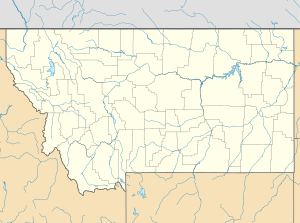Marent Gulch Trestle
Coordinates: 47 ° 0 '12 " N , 114 ° 7' 24" W.
| Marent Gulch Trestle | ||
|---|---|---|
| The first wooden Marent Gulch Trestle in 1883 | ||
| use | Railway bridge | |
| place | Evaro , Missoula County , Montana | |
| Entertained by | Montana Rail Link | |
| construction | Trestle Bridge | |
| overall length | 243 m | |
| opening | 1883 (wood) 1885 (iron) 1927 (steel) |
|
| planner | CC Schneider (1883) George S. Morison (1885) |
|
| location | ||
|
|
||
The Marent Gulch Trestle (also Marent Gulch Viaduct or Marent Trestle ) is a railway bridge over the Marent Valley ( English gulch ) in Missoula County in the state of Montana in the United States , northwest of Missoula on US Highway 93 between Evaro and Wye . The Trestle Bridge , originally made of wood, was provisionally erected during the construction of the Northern Pacific Railway until 1883 and later replaced by a structure made of wrought iron without interruption to operations until 1885 . Today it is operated by the Montana Rail Link .
Wooden construction 1883
During the construction of the Northern Pacific Railway through the Rocky Mountains , the Marent Valley, named after a French settler, had to be crossed northwest of Missoula . Since it was difficult to transport building materials to this heavily forested area, the decision was made to build a temporary wooden trestle bridge, for which over a million board-foot pine (approx. 2,400 cubic meters ) from a radius of five kilometers were built . The 264 m long half-timbered construction was designed by Charles Conrad Schneider . Between the eight pillars there were seven Howe truss girders that led a track 69 m above the valley floor. The pillars were arranged in such a way that the pillars of the later iron structure could be erected between them without having to interrupt the operation of the railway line. Construction work began at the end of 1882, and the first train ran in June of the following year.
Iron construction 1885
Due to the permanent danger of the wooden structure being destroyed by fire, George S. Morison was commissioned to build a trestle bridge made of wrought iron as early as 1884 . Under the direction of Alfred Noble , construction work on the foundations began in September. Construction of the four new bridge piers began in December and by April 1885 work on the new bridge was completed without major interruptions to rail operations. The old wooden structure was dismantled and moved to the neighboring Evaro, with the trusses being reused on other routes for smaller crossings.
The four new 5 to 55 m high bridge piers were each erected on four concrete foundations, with the foundations of the central piers additionally stabilized by pile foundations . The superstructures consist of girder bridges for the driveways of a total of 36.5 m, five truss girders with an overhead track of 35.6 m each and 7.1 m long beams on each pillar. With a total of 243 m, the new construction was 21 m shorter than the wooden construction.
Steel structure 1927
The iron structure was replaced in 1927 with an almost identical steel structure. The bridge has remained almost unchanged since then and is used by an average of six trains per day, with particularly heavy trains being slid over other routes by the Montana Rail Link as a precaution.
Web links
- Kim Briggeman: A beast of history: Huge trestle near Evaro celebrates 125th anniversary. In: Missoulian. October 31, 2008.
literature
- SD Mason: The History of a High Viaduct. In: Journal of the Association of Engineering Societies. Vol. 8, No. 4, 1889, pp. 173-184.
- George S. Morison: The Marent Gulch Viaduct. In: Transactions of the American Society of Civil Engineers. Vol. 25, No. 9, 1891, pp. 305-312.
Individual evidence
- ↑ a b Kim Briggeman: A beast of history: Huge trestle near Evaro celebrates 125th anniversary. In: Missoulian. October 31, 2008.
- ^ Henry C. Meyer: Charles Conrad Schneider. In: The Engineering Record. September 12, 1903, p. 315.
- ^ SD Mason: The History of a High Viaduct. In: Journal of the Association of Engineering Societies. Vol. 8, No. 4, 1889, pp. 173-184, here 173-177.
- ^ A b S. D. Mason: The History of a High Viaduct. In: Journal of the Association of Engineering Societies. Vol. 8, No. 4, 1889, pp. 173-184, here 177-184.
- ↑ Fredric L. Quivik: Historic Bridges of Montana. Historic American Engineering Record, National Park Service, 1982, p. 66.


